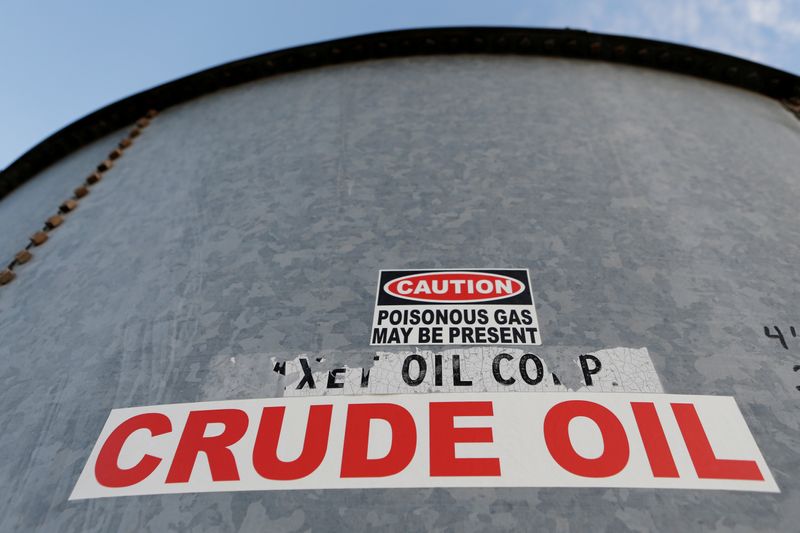By Florence Tan and Shadia Nasralla
SINGAPORE/LONDON (Reuters) - The minimal impact on oil prices from a global deal for record output cuts showed that oil producers have a mountain to climb if they are to restore market balance as the coronavirus shreds demand and sends stockpiles soaring, industry watchers said.
After several days of deliberation, the Organization of the Petroleum Exporting Countries (OPEC) and allies led by Russia hammered out an agreement to cut output by 9.7 million barrels per day in May and June, equal to nearly 10% of global supply.
Other major producers like the United States and Canada gave indirect commitments to cuts as well, playing up forecasts for drastic production declines in coming months due to the free-fall in prices.
The oil market has barely shrugged, however: Brent crude gained 1.5% on Monday, while U.S. crude ended the day lower. The move underscores what both investors and producers already understand - that the monumental deal to cut supply in face of a 30% drop in demand could only accomplish so much initially.
Saudi Arabia's energy minister downplayed the move in oil prices on Monday, saying anticipation of the cuts was the reason for a rally in oil prices before the meeting. Since dipping below $22 a barrel two weeks ago, Brent has rebounded by roughly 48%.
"It's the typical deal, you know: buy the rumour, and sell the news," Prince Abdulaziz bin Salman said.
The minister added on Monday that effective global oil supply cuts would amount to around 19.5 million barrels per day, taking into account the reduction pact agreed by OPEC+, pledges by other G20 nations and oil purchases into reserves. He said that G20 nations had pledged to cut about 3.7 million bpd and that strategic reserves purchases would reach roughly 200 million barrels over the next couple of months,
Both Brent (LCOc1) and WTI (CLc1) have lost more than half of their value this year.
(GRAPHIC: Global oil prices down 50%-60% this year - https://fingfx.thomsonreuters.com/gfx/ce/qzjvqdngpxm/Pasted%20image%201586752163806.png)
The cut by OPEC+ may be more than four times deeper than the previous record set in 2008 and overall oil supply may shrink by twice that with other measures. Yet the reduction remains dwarfed by a demand drop predicted by some forecasters to be as much as 30 million bpd in April.
"Even if these cuts provide a floor to prices they will not be able to boost prices given the scale of inventory builds we are still staring at," Energy Aspects analyst Virendra Chauhan said.
"The absence of hard commitments from the United States or other G20 members is (a) shortcoming of the deal."
Big producers such as Canada, Norway and the United States have yet to commit publicly to fixed quotas. However, U.S. shale output, which accounts for about 75% of overall U.S. crude production, is expected to drop by nearly 400,000 bpd by May, the U.S. Energy Department said on Monday.
Because of the deep OPEC+ cuts, the U.S. shale industry may avoid the worst-case scenario of a 3.5 million bpd production drop, instead falling just 1.8 million bpd, analysts at Bank of America (NYSE:BAC) said on Monday.
"The deal failed to reach the reduction levels anticipated by the market," Takashi Tsukioka, president of the Petroleum Association of Japan (PAJ), said in a statement.
"We hope OPEC+ will continue their talks to stabilise oil markets," he said.
While the core number in the deal suggests a near 10 million bpd cut, Middle East producers such as Saudi Arabia, the United Arab Emirates and Kuwait may have to reduce by more than the 23% cut to which they signed up.
(GRAPHIC: Brent 6-month contango steeper after global output cut deal - https://fingfx.thomsonreuters.com/gfx/ce/jbyprbeqpeo/Brent%20contango.png)
FOCUS ON RESERVES
Energy analysts at FGE expect oil stockpiles in developed nations to grow in the second quarter to levels last seen in 1982.
The Brent futures contango, a market structure whereby future prices are higher than those in the nearer term, deepened on Monday, for both a six-month horizon
The contango in that spread signals concerns about dwindling supply availability. As of the end of March, worldwide onshore crude storage was roughly 83% full, according to shipping tracker Kpler.
The next major focus for markets will be numbers from the U.S. Department of Energy on its strategic petroleum reserves (SPR).
(GRAPHIC: Brent crude forward curve - https://fingfx.thomsonreuters.com/gfx/ce/nmovabwepab/Pasted%20image%201586754436010.png)
A veteran Singapore oil trader, who declined to be named due to company policy, said the inventory build would continue, albeit at a slower pace because of the OPEC+ pact. Saudi Arabia cut its crude selling prices to Asia on Monday, while lifting prices for the United States and leaving prices to Europe unchanged.
"Most of the SPR (held by countries around the world) are pretty full already. Probably China still has some room, but the rest, I doubt there is anything significant," he added.
China, the world's largest oil importer, remains an outlier worldwide, as its demand is rising while most other major nations are seeing demand contract. Its refiners are set to raise crude oil throughput this month by 10% from March as the country where the coronavirus originated recovers from the outbreak faster than elsewhere.

"China is unlikely to make any firm commitment, especially as Far East consumers are still paying a premium for Mideast supplies versus western consumers," one Beijing-based state oil company official said on condition of anonymity, citing company policy.
